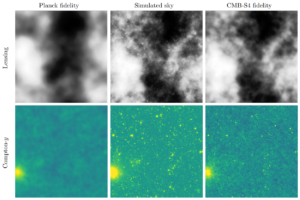Matter in the Universe can be sorted into two categories, “normal” or “baryonic” matter that is described by the Standard Model of particle physics and “dark” matter that has only been observed to interact gravitationally. Observations indicate that the density of dark matter is more than five times greater than baryonic matter, and most of the baryonic matter is in the form of hot ionized gas rather than cold gas or stars. CMB-S4 will be able to map out normal and dark matter separately by measuring the fluctuations in the total mass density and the ionized gas density.
Differences in the matter density across the Universe source gravitational potentials. These potentials bend light and distort our view of background objects in a process called gravitational lensing. Because the mechanism for the distortions is well understood, we can use them to reconstruct fluctuations in the matter density. The CMB is the oldest and furthest light in the Universe, and with the CMB as the background source, virtually all of the density fluctuations in the observable Universe leave an imprint. The map resulting from CMB lensing reconstruction will be wide-area, highly sensitive, and extremely well-calibrated.
We can use this map to precisely measure the amplitude of large-scale structure at intermediate redshifts, with important applications to dark energy, modified gravity, and studies of neutrino masses. In concert with other observations, we can use this map to find the mean mass for a catalog of objects (for example, of galaxies and galaxy clusters). By calibrating cluster masses, the abundance of galaxy clusters can be used as a probe of dark energy and neutrino masses. Combined with optical galaxy surveys and measurements of the gravitational lensing of galaxies, CMB-S4 will probe the connection between visible baryons and the underlying dark-matter scaffolding over the course of cosmic history.
Baryons in the universe today are thought to mostly exist in a diffuse ionized plasma that is difficult to observe. This ionized plasma can leave imprints by scattering the CMB light (through the so-called Sunyaev-Zeldovich effects). One effect, due to scattering from hot electrons, leads to a characteristic distortion to the energy spectrum of the CMB radiation. The nature of this scattering allows us to find reservoirs of hot electrons (like galaxy clusters), regardless of distance. The CMB-S4 catalog will be more than an order of magnitude larger than current catalogs, and will be especially adept at finding the most distant clusters. The same effect allows us to measure the profile of the gas pressure in the clusters.
Another effect is sensitive to the combination of gas density and velocity. Combined with data from other surveys, CMB-S4 can probe the gas density around galaxies and clusters of galaxies. It will constrain the energy input to the gas from central black holes in active galactic nuclei and from supernova explosions of stars. With constraints on velocity, CMB-S4 can test alternative models of gravity. Patterns in the distribution of the earliest gas to be ionized can give us insight into the first stars.
Finally, in the natural course of its survey, CMB-S4 will catalog the emission from objects in the millimeter-wavelength band, including active galactic nuclei and distant and dusty star-forming galaxies. The matter in our own Galaxy will also be mapped to exquisite sensitivity in intensity and linear polarization over a large fraction of the sky.
